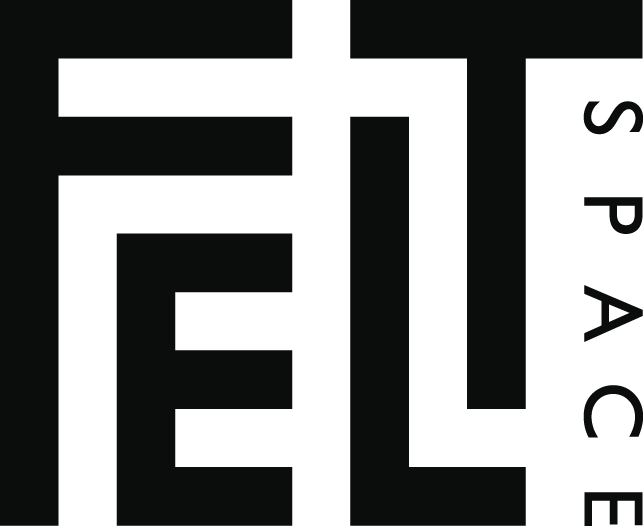This month’s FELTspace exhibition explores the line between transgression and purity, mundanity and philosophy, human and machine.
Upon entering the FELTspace gallery, immediately we feel profound reverence for the carefully placed works, particularly those which make up Isabella Hone-Saunders’ Ritual Slaughterer, shown in the front gallery.
This is the largest exhibit, featuring physical forms of steel, ceramics, wrought iron, challah and cedar in addition to multimedia elements of video and audio. The proverbial star of the exhibit is ‘To float, so ungraspably’, or the ‘skip bin mikveh’, which is the central piece in the gallery.
A mikveh is an immersion pool which carries rich symbolism of transformation, purity, and cleansing, used for a variety of reasons in Judaism, mainly to achieve ritual purity.
Hone-Saunders’ version of this is a bent, rusted-out skip lined with contrasting oyster-blue tiles. A piece of Perspex holds a thin layer of shimmering water that tricks the eye; one could believe the tub was entirely full.
The skip’s glistening crystal-like water permeates with piety, while its oxidised outer layer is symbolic of the human tendency to erode and transform the simple purities of God and religion into something more sinister.
For Hone-Saunders, an example of this ideological curdling is seen in the occupation of Palestine. The artist spoke of their pro-Palestinian views at the exhibition’s opening, saying the work attempts to “demonstrate that Judaism is not inextricably linked to Israel’s Zionist genocidal agenda”.
The idea of erosion can also be seen in ‘Friday Night’ – challah drenched in adhesive to prevent decay. ‘Friday Night’, like the entirety of Ritual Slaughter, pays homage to familial ties. The traditional ritual of baking challah for Shabbat was an act of personal research in the artist’s reconstruction of their Jewish identity.
The intimacy of family is palpable in the gallery, with photos of their great-grandfather’s home giving us a rare peek into the personal realm of those who devote their lives entirely to God.
‘To float, so ungraspably’ also references family in its materials. The artist’s father worked as a builder, and likely tossed waste into skips bins like this one. Hone-Saunders has intentionally converted the skip from an object of refuse to one of cleanliness. They do say it’s next to godliness.
Duality pervades the work. Hone-Saunders “reframes rituals through an activist, queer and anticolonial lens”, unshrouding the illusion of religion with illusionary water. Hone-Saunders’ artistic statement references kissing their friend in the bathroom stalls in Adelaide’s first synagogue (now queer club Mary’s Poppin), the same halls their grandfather performed shechita and where the rainwater and tap water hashoko (to kiss) become pure in the mikveh.
Hone-Saunders reforms archaic structures that seek to exclude, borrowing and transgressing in the process. The bent-out dilapidated skip bin perhaps symbolises the bending of faith and dialogues surrounding the culture we are allowed to belong to.
According to halakha (Jewish laws) based on the Talmud and Oral Torah, to be Jewish by birth, you must be born to a Jewish mother. This restriction saw Hone-Saunders (whose Judaism follows a paternal line) unable to bathe in the St Kilda East Mikvah, despite having 37 per cent European Jew heritage encoded into their DNA. Pointedly, this DNA result, once a piece in the exhibition, was stolen from the Melbourne gallery it sat in.
The work in Ritual Slaughter is diverse, nuanced and entirely intimate, offering a glimpse into Hone-Saunders’ personal history, and causes us to think about the relationships we forge within our own family.
In the artists own words: “I don’t have culture, but I do. I borrow, I transgress”.
Moving to the gallery at the back of FELTspace, the browns of wrought iron and bread are replaced with neon blue, yellow, and green. A lighter air awaits.
Golden macaroni by Madeleine Minack and Kaijern Koo asks us to examine the big questions, which is a vague enough premise to almost instantly dismiss. However, sincere ponderance is to be encouraged while in the space.
Paddle pop stick sculptures transport me to a simpler, less jaded time. Weaving like chooks in a tightly packed coop, we are asked to re-examine what informs and influences us through quirky miscellanea – which includes chook bean bags.
Outside the gallery, Paige Glancey, Anika Gardner and Nic Scage’s Maladjusted screens at sundown on the front window, presenting a hyper-reality of Moonta’s abandoned copper mines.
The work consists of an AI bot iterating beyond its greedy overlord’s coding, creating glitchy feedback effects, retro colours and gaming text which harks back to the world of Roland Edirol V8 analogue video mixers from a decade or so ago.
This dated aesthetic, mixed with the AI narrative “as understood by ya miners at the pub”, presents a sense of irony and humour.
Standing and staring at the flickering image, a sentiment we last felt while watching Ridley Scott’s Blade Runner washes over us.
We’re left sympathising with the on-screen Replicants as they fall into a desperate embrace. Error. Error. Error.
